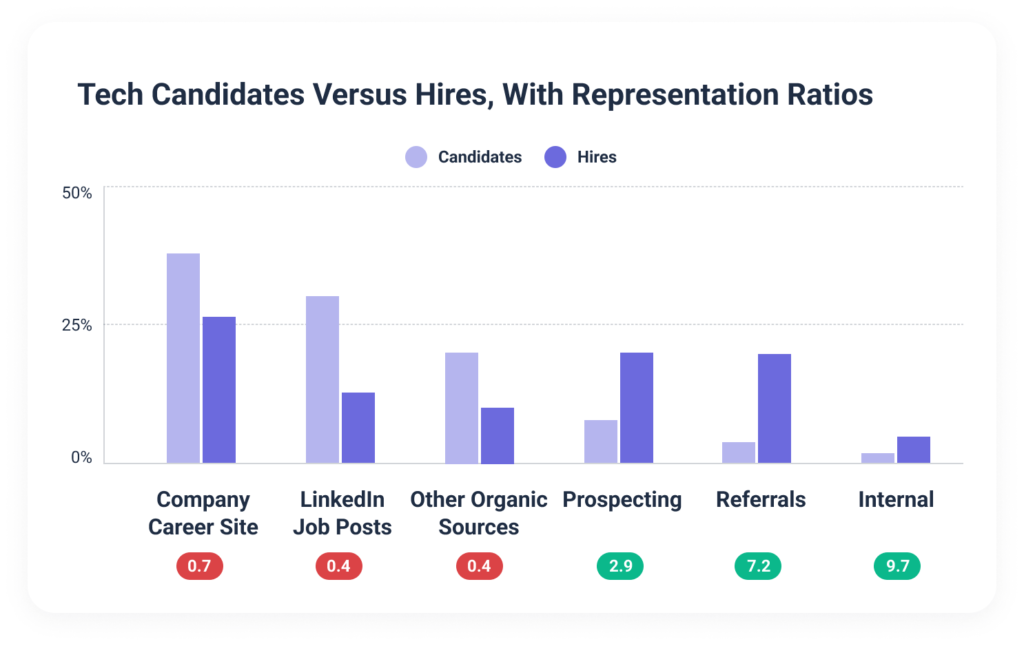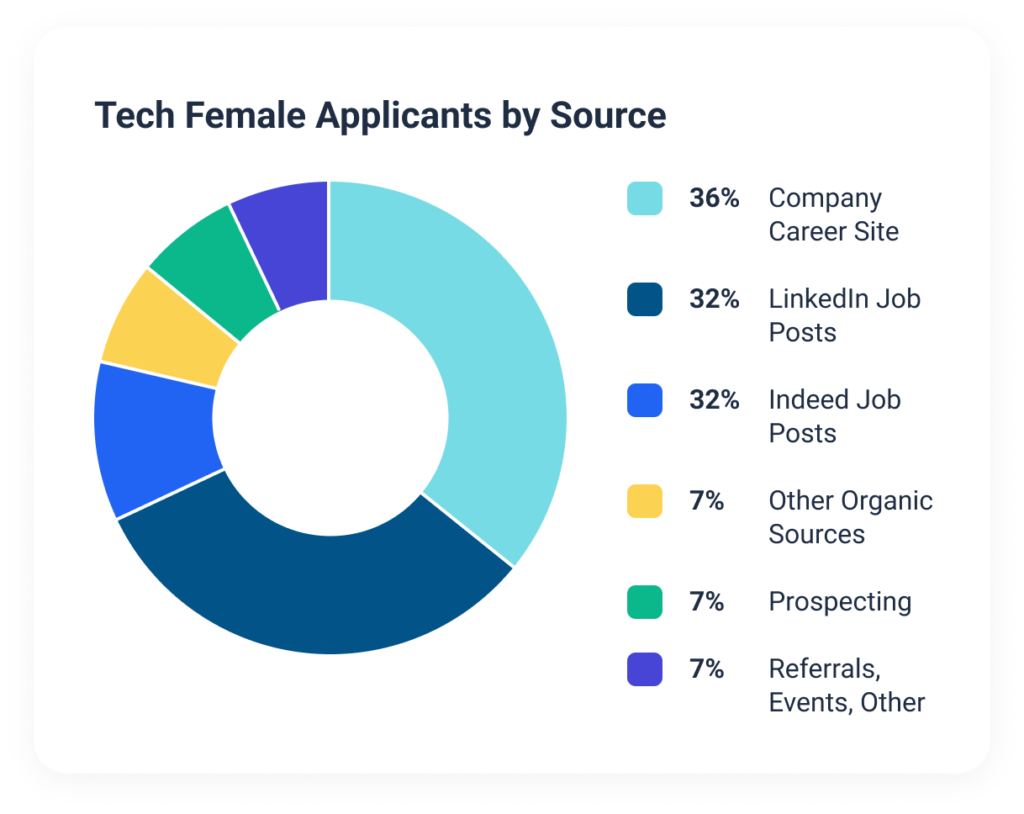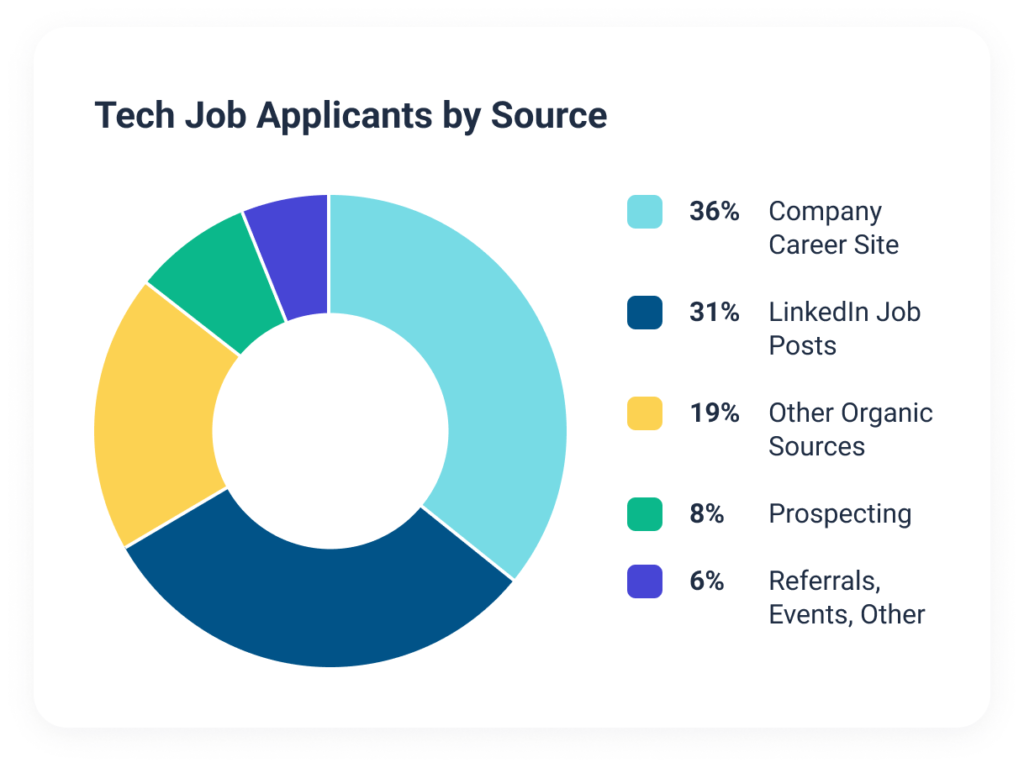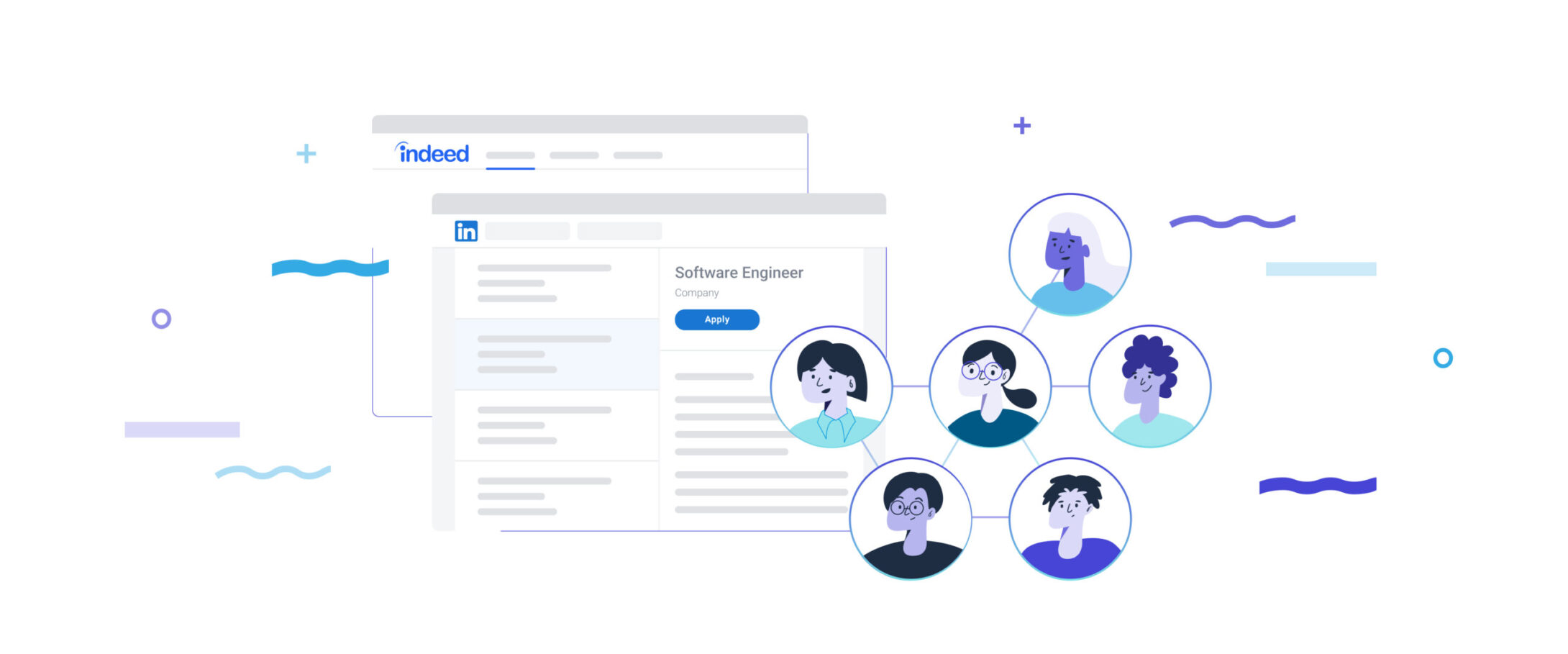A couple of myths are floating around the talent acquisition industry these days. One is that candidate sourcing is an equitable approach to DEI (diversity, equity, and inclusion). The other is that inbound recruiting is inefficient.
Neither is the case. Basically, there’s no need to manufacture diversity through candidate sourcing if the top of your applicant funnel is already diverse. And inbound recruiting is very efficient, enabling hiring teams to attract larger, more qualified, and more diverse applicant pools. Just as long as you get one thing right: the job post.
Potential problematic candidate sourcing channels
Recruiting teams rely on various types of candidate sourcing channels. Rather than wait for job seekers to reply to job ads, recruiters use these channels to actively seek out potential candidates. Some of these channels are open (public), others are closed (invitation-only). All are subject to the unconscious biases of the sourcer.
Recruiter sourcing
This is when individual recruiters use LinkedIn and other sites to seek out candidates. It lets them target potential candidates with the specific experiences or skills required for their open roles. But it also creates numerous opportunities for bias to creep in, from engaging only people with name-brand employers or schools in their profiles to using profile pictures as the basis for moving candidates out of (or into) the funnel.
(While a recruiter may have the best of intentions when sourcing a prospective candidate who appears to be from an underrepresented group, this can lead to tokenism as well as diversity at the cost of inclusion.)
Diversity recruitment
Diversity recruitment usually entails a diversity recruiter heading up the effort to recruit candidates from underrepresented groups. While the commitment is admirable, the problem here is that putting it all on one recruiter alleviates other recruiters from the responsibility. Hiring fairly, inclusively, and for diversity is every recruiter’s job, not just that of a single recruiter or dedicated team.
Third-party sourcers
When hiring teams outsource the effort to a third-party recruiting firm that has a larger pool to source from, they may increase their reach while reserving their own internal bandwidth. But the recruiting effort is still limited by the size of the outside firm’s pool of job seekers. And, more importantly, the hiring team may be subverting their own agenda (i.e., finding the best candidate) with that of the recruiting firm (i.e., placing a certain number of candidates).
Referral programs
While most recruiting leaders don’t put referrals and sourcing together, they are a part of the same effort to create a more robust candidate pool – perhaps unfairly. Referral programs bring in candidates, but they usually only bring in job seekers who have a connection to someone at the company.
Apart from limiting the candidate pool, referral programs also set up a system of privilege in your hiring process and may thwart your diversity efforts if your organization isn’t diverse to begin with.
Myth #1: Candidate sourcing is an equitable approach to DEI
Right out of the gate, candidate sourcing limits the number of job seekers encouraged to apply for a given role. Which isn’t equitable. It also invites unconscious biases to influence the candidates chosen. Which isn’t inclusive.
DEI is nowhere near as simple as targeting certain candidates to increase diversity. And while candidate sourcing can help hiring teams grow their applicant pools, how fair is it to job seekers whom hiring teams don’t target?
There’s a lot of talk these days about various candidate sourcing methods, from on-demand sourcing to referral bonus platforms and more. The general thread is that they offer proactive approaches to DEI.
But, really, they’re just attempts to artificially manufacture diversity, similar to diversity hacks like the Rooney Rule. Meanwhile, our research shows that a qualified, diverse top of the funnel yields a qualified, diverse bottom of the funnel. So there’s no need to target job seekers or wedge in diversity hacks. (Here’s our lead research scientist, Maryam Jahanshahi, talking about our research.)
Candidate sourcing and the optics of DEI
There’s also the question of how it looks when a sourcer reaches out to a candidate from an underrepresented group and mentions DEI.
What is the recruiter really conveying? That the company is committed to diversity? That the recruiter needs to check the diversity box to meet a company quota? Or that the recruiter is just mentioning DEI because it’s a buzzword?
A lot of hiring teams are doing diversity sourcing these days. That means candidates are left to wonder exactly why a recruiter is contacting them. Is it because of their abilities, expertise, and experience or because they appear to belong to an underrepresented group? Unless the sentiment is genuine, it can feel contrived or pandering.
That’s especially true if the candidate looks at the company’s website and sees few or no faces similar to theirs. Maybe the organization is just getting started with inclusion efforts, or maybe they’re just trying to hit target diversity numbers. Job seekers won’t know.
The makeup of the hiring team can be a clue for candidates, which is why it’s important to have diverse hiring teams. And the hiring process itself can be revealing as well. For example, does your hiring team include women and people of color? Does your hiring team take cultural or socioeconomic factors into account (e.g., do they understand that some job seekers don’t own a car or live in a space conducive to virtual interviews)?
If the clues don’t add up to a genuine effort to help people from underrepresented groups, candidates from those groups may sense it. They may feel like the company is only interested in them as a token.
Why employee referrals can be particularly problematic
Then there’s the inherent inequity and inefficiency of referral programs. Not only do employee referral programs tend to favor referred candidates, they also tend to perpetuate whatever lack of diversity already exists.
As a whole, referral programs can exclude large swaths of qualified job seekers who don’t know anyone at the company. If a job seeker gets a referral before the job posting goes live, they may get an offer before anyone else has even seen the job post.
Also, when an employee refers someone, the hiring team may favor that candidate without even realizing it. Actually, this is more common than you may realize.
In a recent analysis of jobs data from 10,000 U.S.-based employers, our science team found a number of recruiting trends. One of these trends was a heavy bias towards applicants from referrals.
These applicants are, on average, 9 times more likely to get an offer than applicants from inbound recruiting efforts. Which is eye-opening, given that inbound recruiting channels bring in the majority of applicants.
In fact, over 80% of all applicants come from inbound recruiting channels like company career pages, Indeed, LinkedIn, and other online job boards. Yet these applicants are only half of all hires. Meaning hiring teams are favoring referred applicants disproportionately.
(In the chart below, we use a representation ratio to establish bias for or against a channel. A value of 1 suggests proportionate hiring, less than 1 suggests bias against, and more than 1 suggests bias towards.)

Referrals tend to perpetuate the existing cultural and racial makeup at your company. By bringing on candidates similar to existing employees, referral programs can inadvertently create homogenous cultures.
(Note: If referrals play an outsized role in your hiring process, they may be negatively impacting your applicant pools. One way to make the referral process fairer is to use blind referrals. With blind referrals, which we use here at Datapeople, hiring managers and interviewers don’t learn that a candidate came through the company’s referral program.)
Inbound recruiting, on the other hand…
Although inbound recruiting isn’t necessarily in vogue at the moment, it fits perfectly with the latest approaches to DEI. Because inbound recruiting represents the most democratic approach toward attracting applicants.
Rather than targeting specific types of job seekers, inbound recruiting opens the process to all qualified job seekers. By casting as wide a net as possible, you can attract a large, qualified, and diverse applicant pool at the top of the funnel. Once you have that, your final candidate pool will be naturally diverse as well.
Inbound recruiting emphasizes inclusion over exclusion. All anyone needs to apply is a resume and internet access. And the results are clear. For example, the overwhelming majority (85%) of female tech job seekers apply through inbound recruiting channels.

Myth #2: Inbound recruiting is inefficient
With the Great Reshuffle, the battle over return-to-office versus remote work, and a tight labor market in numerous industries, recruiting teams have never faced more challenges. It’s no wonder they’re turning to whatever recruiting methods they think may work (including inflating job titles and using business jargon to try to spice things up).
And candidate sourcing tactics can feel proactive, and therefore more efficient. Although they require using up resources and budget prospecting, managing referral programs, paying third-party sourcers, and the like.
It’s also no surprise that some hiring teams view inbound recruiting as inefficient. Large candidate pools aren’t much help unless they’re filled with qualified candidates. And small candidate pools with no qualified applicants aren’t any use to anyone.
But the inbound recruiting channel isn’t the issue here ─ it’s the job description. Simply put, a job post is still the most important tool in the recruiter toolbox. It often represents the only piece of messaging a potential candidate sees from your company. Which means it can make or break your recruiting effort.
For example, look at job requirements. Very simply, unclear requirements can discourage qualified job seekers and encourage unqualified job seekers. Clear requirements, on the other hand, can help job seekers self-select, making it a lot easier on your hiring team.
Inbound recruiting requires that you get the job post right. But if you do, you can attract great applicant pools just by writing inclusive job postings and publishing them on your website, LinkedIn, and job boards.
Inbound recruiting works, if done correctly
Again, the vast majority of applicants come from inbound recruiting sources. Most of those come from either a company’s career page or LinkedIn. (Given the recent popularity of tech hiring platforms like Hired and TripleByte, it’s notable that LinkedIn still outperforms them.) In other words, potential candidates are out there.

Inclusive inbound recruiting can increase the number of qualified candidates your jobs attract. For example, several of our customers have attracted larger qualified applicant pools using inclusive job postings. One Acre Fund attracted 30% more qualified applicants, while BuzzFeed attracted 125% more qualified applicants.
Inclusive inbound recruiting can also decrease time to fill. While seeing a 117% increase in applicants, our customer DoorDash also saw a 30% decrease in time to fill when using inclusive job postings.
These results from DoorDash, One Acre Fund, and BuzzFeed didn’t come by magic. The companies improved their jobs posts (using Datapeople), which led to more visibility and more applications from qualified candidates of all backgrounds.
There’s no shortcut to DEI and fair hiring. On the one hand, candidate sourcing can help hiring teams develop their applicant funnels and target job seekers from underrepresented groups. But on the other hand, candidate sourcing isn’t the most equitable approach.
Fairness in hiring doesn’t come from hiring practices based on connections or privilege. And diversity doesn’t come from lip service to DEI in a job ad or LinkedIn message. They come from inclusive job posts that welcome all qualified applicants and naturally attract diverse applicant pools.
Meanwhile, unlike the myth suggests, inbound recruiting can be very efficient. With inclusive job postings (our language analytics editor can help), you can increase the size, quality, and diversity of your candidate pools. You can also reduce overall time to fill. And, finally, you can rely less on candidate sourcing.
